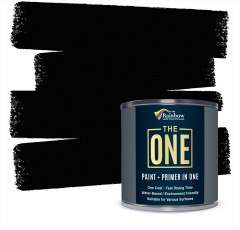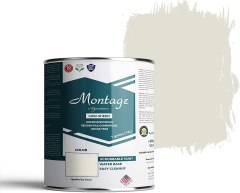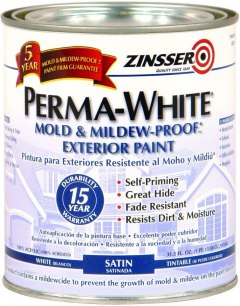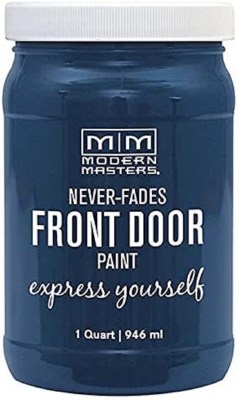BestReviews is reader-supported and may earn an affiliate commission. Details

Our home improvement expert recommends this paint for trim, doors, and furniture.
Combination paint and primer. Thick paint goes on smooth. Low VOC is better for the environment and easy to clean up with soap and water. Quick-drying.
Does not cover as much ground as other paints.

An eco-friendly and reasonably priced paint that is approved by our expert.
Paint made with high-quality, pollutant-free materials. Covered by a 10-year premium warranty. Specialty finish allows for smooth application and maximum coverage. Sealing protects against mold and mildew.
Odor is quite strong, which is fine for exterior use but harsh with internal use.

An easy and simple-to-use option that comes from a go-to brand in quality paint, according to our expert.
A self-priming formula that requires no sanding prior to painting. Contains mildewcide and protects against mold and mildew for up to 5 years. Color is fade-resistant.
More expensive than other brands on the market.

A smooth, durable 2-in-1 paint/primer that our expert notes is good for multiple surfaces.
High-hiding formula provides smooth application and excellent coverage. Easy to clean up. Paint is durable and washable when dry with mildew-resistant coating.
May need more than one coat to get paint's true color.

Vibrant paint color best for smaller projects; our expert likes that it is resistant to fading from the sun.
Water-based formula provides long-lasting durability. Paint dries quickly, only taking 1 hour. Paint is easy to maintain and can cover up to 100 sq ft. Able to use both inside and outside.
Sometimes dries a little too fast for larger projects.

We recommend these products based on an intensive research process that's designed to cut through the noise and find the top products in this space. Guided by experts, we spend hours looking into the factors that matter, to bring you these selections.

Painting your house isn’t something you do often, but when the time comes around again you want to make sure you get the best exterior house paint for the job. These are products that are constantly being improved, and it’s unlikely that what you bought the last time is still available.
And that is good news because today’s exterior house paints are almost invariably better than what you used last time. However, shopping can get confusing. It’s not just a question of color or sheen (surface finish). With more and more emphasis on the environmental impact of protective and decorative finishes, you want to think about the paint’s chemical composition in addition to the curb appeal your paint adds..

All exterior house paint falls into one of two categories: oil based (also called solvent based), and water based (also known as latex and/or acrylic).
Go back a decade and water-based paints were really only used indoors, but now they’re much tougher and longer lasting. Wherever possible, we would recommend water-based paints for several reasons.
They are kinder to the environment and to you.
They clean up with soap and water (oil-based paints need turpentine or thinners).
They dry more quickly.
They have greater UV resistance and so, in general, retain their color longer.
They’re breathable and so don’t trap moisture that can cause mold and mildew.
If you have steel railings or other metal structures to paint, oil-based paints are still recommended because they adhere better to those surfaces and create a hard-wearing skin. On everything else, water-based latex paints offer more flexibility: they’re as good for siding as they are for plain walls.
Although the surface finish is a personal choice, it’s something you need to consider at the outset because while some manufacturers offer a wide variety of finishes — and even interior and exterior versions of the same paint — others have a more restricted range.
It’s common to use a flat (matte) or low-sheen finish for concrete, brick, or stucco and a satin, semigloss, or gloss for window frames and doors.
The less reflective the finish, the better it hides any imperfections. Putting gloss on an uneven surface can cause unattractive shadows and highlight worn areas. If you use a flat finish, those same flaws will usually go unnoticed.
Also bear in mind that even if you buy the same color from the same maker, a matte finish will look quite different than a semigloss or gloss finish. If you can get a sample can, it’s a good idea to do a patch test on an area in the back of your house or another place that’s likely to go unnoticed or can be concealed.
Putting a gloss finish over a surface that was previously matte is easier, but if you want to do the reverse you’ll likely have to sand the surface in order for the new paint to adhere properly.
It’s likely there will be a minor difference between the color you see on the screen of your computer, tablet, or phone and the color of the paint in real life. Many manufacturers will sell you a small sample first so you can check. If you need a precise match, you’ll need a custom mix from a local paint retailer. Make sure you keep the color ticket provided so you can get more if necessary.
Most exterior paint manufacturers claim that their product offers excellent opacity — it will cover previous coats without those coats showing through. In practice, this isn’t always as successful as the maker suggests. You’ll probably need two coats and in some cases three. It’s very difficult to cover a dark color with a lighter one. If you really must do that, it will probably be quicker in the long run to strip off the old paint if at all possible.

Paint roller: Bates Paint Roller and Brush Set
This low-cost set has everything you need from paint tray to main and detail rollers to cutting-in brush and pad for those tricky areas. The main roller is a pro-standard 9-inch model with a threaded handle that will accept an extension pole.
Work gloves: Dex Fit Nitrile Work Gloves
Solvent-based paints aren’t good for your hands, and even water-based products can be difficult to get off your skin. These gloves are made of a mixture of nylon and spandex for great fit and comfort. They give plenty of feel and won’t slip when wet. They’re machine washable, too.
You’ll sometimes find cheap exterior house paint on special at your local store. It might only be $10 or $15 a gallon, but you need to be careful that the stock is not out of date. We would expect prices to start at around $20 a gallon for basic flat white.
Most exterior house paints cost between $30 and $45 a gallon. Flat is the cheaper variation, satin, semigloss, and gloss usually cost progressively more. We know budget is always a factor but investing in quality paint is usually worth it. It means your house will look better for longer.
You’ll probably pay a few dollars extra if you’re buying a custom mix. If you want the most environmentally friendly (and least harmful) zero-VOC exterior house paints, you’ll probably pay upwards of $50 per gallon.

A good exterior house paint can last seven to ten years, but it’s important that it’s applied properly. This general advice will help you do a great job.
Prepare carefully. Don’t “paint over the cracks.” Those faults will be harder to rectify later. Now is the time to do all those little maintenance jobs you’ve been putting off.
Wash thoroughly. Scrub off any old, flaking paint. Fill and sand where necessary. Applying a primer is usually a good idea because it improves the adhesion of the top layer of paint. However, it depends on the exterior paint you’ve chosen. Some are all-in-one primer and top coat.
Paint from the top of the house down. That way you’re always working away from newly painted areas and won’t risk damaging them, which could happen if you work from the bottom up.
Avoid temperature extremes and high humidity. Try to paint on cooler days with lower humidity. The manufacturer usually indicates the minimum and maximum temperatures on the can, but high humidity can cause more problems than high temperatures.
Wait 24 hours between coats. Although some paints claim to cover in one coat, that tends to be in ideal conditions (whatever they are). In our experience, a second coat is often required. Although the first coat will probably dry in a couple of hours, it’s usually suggested that you wait 24 hours before adding the second.

A. You can. Choose a cool day. Don’t work in hot or humid conditions. It might appear that the paint dries more quickly, but it may not adhere properly.
It’s important to clean the surface thoroughly before painting (a solution of 30% white vinegar and 70% water is popular; laundry detergent is another option). You could use a pressure washer, but you’ll do a better job if you get up close and personal with a soft bristle brush. Rinse with plain water. If bare patches of aluminum are showing, it’s a good idea to use a primer. Otherwise, it isn’t necessary. Use an acrylic latex paint, which has the flex necessary to cope with the movement of the siding as the weather changes.
A. Volatile organic compounds are certainly something you should minimize, and paint manufacturers are working toward lowering their levels all the time. VOCs release into the air while you’re painting, and when painting indoors they can give you a headache if you aren’t wearing a respirator or haven’t ventilated the room properly. Some VOCs have been identified as carcinogens, and the EPA now sets legal limits on them. For any house paint (interior or exterior) to be called “low VOC,” there is a maximum number of grams per liter of VOCs the paint may contain. For water-based paint, that number is 250; for oil-based paint, that number is 380. Many are much lower. Paints are considered VOC-free if they have less than 5 grams per liter. Currently, these paints are quite difficult to find and expensive.
A. It’s best to leave the lid off the can so the paint dries out. If it’s water-based paint, it can then be thrown in the trash, although increasingly there are curbside collections to recycle the metal from the can. If it’s oil-based paint, it contains hazardous chemicals and needs to be disposed of properly. Check the website of your municipality for disposal of paint in your area.
Get emails you’ll love.
Learn about the products you’re wondering if you should buy and get advice on using your latest purchases.
